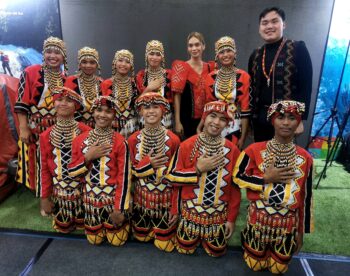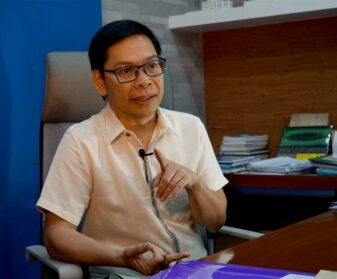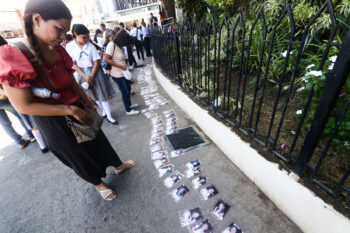DAVAO CITY (MindaNews/01 January) — Start the peace talks. Begin at the end. Pre-empt history.
It’s easy enough to just demand that the talks begin. But the government has boxed itself into a wee bit of a tight corner by laying down a precondition for the resumption of the talks. Those of us who are experienced mothers (or grandmothers) know that “hala ka!” can be either a threat or a done deal. Government says: No talks unless the Malaysian facilitator is changed. MILF says: He stays. Malaysia says: He stays. Done deal. Threat fizzles.
I don’t want to add more fuel to the fire by giving my two bits about whether the facilitator is in fact biased or not toward the MILF and therefore cannot be trusted to be neutral and constructive. I would think that if one party to the talks says we can’t work with him, you’d think it would be easy enough to just get someone else. But not when you’re looking at “national interest” (Malaysia’s and ours), face (Malaysia’s and ours), and just plain old-fashioned “interests” (Malaysia’s, ours, and MILF’s).
So how to begin the begin? Threaten with another threat? I don’t think so. Let’s look at all three above. In negotiations, parties who look for their common interests manage to solve the problem. Turn off the microphones. Stop the press releases. It is time for a listener to see the government, Malaysian and MILF decision-makers. Listening never hurt anybody. Better than saying “hala ka!”. Go look for a listener. And do it this week!
Now we can talk about “beginning at the end.” What is at the end of the peace talks? A peace agreement? Well, yes. But really we should go further than that. That’s the easy part, you know (I’m not kidding you.) What to do the DAY AFTER the peace agreement is signed is a good way to think about what to put in the peace agreement. I am sure there are going to be big words in there. We all heard about ancestral domain, of course. Those two words come with constitutional, territorial, security, and development “must do’s”. From the get go, that agreement has to be ready for implementation. This is sometimes called “sincerity” but I daresay it is nothing but common sense. You make an agreement that you can implement, right? Make it simple. Go back to the original meaning of “institution”. Governance 101 defines an institution as a “set of rules.” So the peace agreement, to be implementable, must list down the “set of rules” (the institution) that will be followed by the two parties – and the people, too. Including their existing institutions like Congress and the Senate – to make sure things WORK. Okay, the ceremonies will be important. But I will be looking for the “set of rules.”
And while we’re at it, let’s talk about making sure women have a say in that set of rules. Too many times, women are told they are important because they hold the families together in times of war. Well, they also hold families together in the aftermath of war. I’d like to see in the peace agreement an answer to a basic and endearing definition of peace from an exhausted woman who had fled hearth and home too many times. “Peace is having time to beautify myself.” Can you imagine the depth of tiredness from where this comes? The woman just wants time to comb her hair! Or to take a relaxing bath! The jargon is “food security, democratic self-governance, social cohesion, etc.” But in the end, it is lifting her burdens, accepting her abilities, and giving back the joy in her life! It has been difficult to tell the panels that making peace is a woman’s business as well. Too few of us have challenged the notion that “Men make peace because they make war.” This is a good enough reason for women to be involved in peace negotiations. But there are others too. Women view the world differently. This comes primarily from the roles they are made to play in their communities as well as the expectations people have of them. So they are expert in arranging the sets of rules in a way that works not only for their families but also for their communities. And isn’t it time to “arrange” things differently?
The Bangsamoro struggle is a struggle for re-arrangement. Where do the Bangsamoro as a people sit at the table of the country? (Or do they even sit at the table!) This, in the end, is the problem that has to be faced. In conflict that keeps returning generation after generation, this is the central issue: a place at the table for different peoples. It is at the heart of democracy. But our nation building has been focused on what has been called “privileging singular identities.” How does a minority people with their own distinct history relate to the State? For too long we have held that the majority decides who sits at the table, how they sit, and when they sit (and for many, how long they sit!) Gandhi said it ever so eloquently: “I do not believe in the doctrine of the greatest good of the greatest number. It means in its nakedness that in order to achieve the supposed good of 51 per cent the interest of the 49 per cent may be, or rather, should be sacrificed. It is a heartless doctrine and has done harm to humanity. The only real, dignified human doctrine is the greatest good of all, and this can only be achieved by uttermost self-sacrifice.” Power sharing is one of the most challenging issues in the negotiations and its “re-arrangement” fraught with the most meaning but self-sacrifice is needed. This is the preparation that has to be made among our people. Self-sacrifice. What are you giving (not giving up) for peace? This is a huge factor in our ability to implement the peace agreement. President Noynoy is in a great position to ask for this sacrifice, in a way that Gloria Arroyo wasn’t. It needs a popular leader to ask for sacrifice from the people so I hope PNoy starts preparing that ground to make the seeds of peace sprout and grow.
In this moment of re-arrangement – nay, of transformation – in our country, I pray that we see that we can go and pre-empt history.
I love a campaign ad that was used to celebrate the 60th year of India as a free nation. This ad has resonated with me deeply because what it says rings true for the Philippines as well. It talks of two Indias (the same way that there are two Philippines): “one.. straining at the leash eager to spring forth to live up to the adjectives that the world has been recently showering upon us; the other …is the leash.” The last lines of the ad speak to us as well. “History, they say, is a bad motorist. It rarely ever signals its intentions when it’s making a turn. THIS is that rarely ever moment. History is turning a page.” And the Philippines, like India today, is at the “edge of time’s great precipice.” One Philippines is “looking down at the bottom of the ravine and hesitating.” The other is “looking up at the sky and saying: It’s time to fly!”
[This piece is one of 20 on the theme, “Let the Talks Begin” in the first issue of OUR Mindanao, a monthly publication of the Mindanao News and Information Cooperative Center (MNICC) which runs MindaNews and mindanews.com. Irene Morada Santiago is Chair and Chief Executive Officer of the Mindanao Commission on Women. She was a member of the government peace panel in the negotiations with the MILF from 2001 to 2004]







